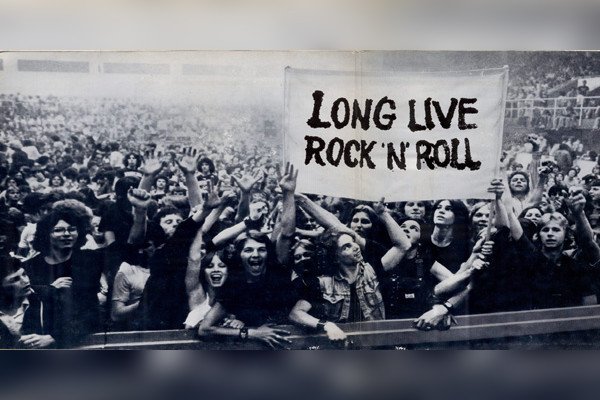The cultural revolution of rock ‘n’ roll began in the early 1950s, forever changing the landscape of American society. Rock ‘n’ roll emerged from a fusion of rhythm and blues, country, and gospel music, creating a new sound that crossed racial boundaries and united young people across social classes.
The music industry transformed as artists like Elvis Presley, Chuck Berry, and Little Richard brought this energetic new genre to mainstream audiences. Their performances challenged social norms and sparked conversations about race, sexuality, and generational values in post-war America.
This musical movement coincided with the rise of teenage culture, television, and new recording technologies. Young people found their voice through rock ‘n’ roll, using music as a form of self-expression and rebellion against traditional values.
Origins of Rock ‘n’ Roll
Rock ‘n’ roll emerged in the 1950s as a groundbreaking fusion of musical traditions that transformed American culture. This new sound combined elements from African American rhythm and blues with country and western music, creating an energetic style that appealed to young audiences across racial boundaries.
Influence of African American Music
African American musical traditions laid the essential foundation for rock ‘n’ roll through rhythm and blues, gospel, and jazz. Black musicians in the 1940s developed a powerful, uptempo style of R&B that featured driving rhythms and emotional vocals.
Artists like Louis Jordan and Sister Rosetta Tharpe pioneered electric guitar techniques and energetic performances that would define rock ‘n’ roll’s sound and style.
The call-and-response patterns from gospel music and the blues scales became fundamental elements of rock music. Many early rock hits were direct adaptations of R&B songs, with black artists like Chuck Berry and Little Richard leading the way.
Fusion of Blues and Country
The marriage of blues and country music created rock ‘n’ roll’s distinctive sound. White country artists began incorporating R&B elements into their music, while black musicians experimented with country styles.
Elvis Presley exemplified this fusion at Sun Records in Memphis, where he recorded blues songs with a country twang. Producer Sam Phillips actively sought to blend these styles, creating what he called “black music for white people.”
Regional recording studios like Sun Records and Chess Records played crucial roles in developing this new sound. Musicians from both traditions shared stages and recording sessions, breaking down musical and social barriers in the process.
Pioneers of Rock ‘n’ Roll
The architects of rock ‘n’ roll emerged in the 1950s, bringing revolutionary musical styles that merged rhythm and blues, country, and gospel. These innovative artists created signature sounds and performance techniques that defined the genre.
Elvis Presley: The King of Rock ‘n’ Roll
Elvis Presley burst onto the music scene in 1954 with his debut single “That’s All Right” at Sun Records in Memphis. His unique blend of country, blues, and rockabilly created a distinctive sound that captivated audiences.
Presley’s provocative hip movements and magnetic stage presence sparked both controversy and admiration across America. His television appearances on The Ed Sullivan Show drew record-breaking viewership numbers.
Between 1956 and 1958, Elvis released multiple hit singles including “Heartbreak Hotel,” “Hound Dog,” and “Jailhouse Rock.” His influence extended beyond music into fashion and youth culture.
Chuck Berry and Guitar Solos
Chuck Berry pioneered the electric guitar techniques that became fundamental to rock music. His signature “duck walk” and double-string bends created an unmistakable style.
His 1955 hit “Maybellene” established the guitar riff as a crucial rock element. Berry wrote lyrics about teenage life, cars, and romance that resonated with young audiences.
Notable songs like “Johnny B. Goode” and “Roll Over Beethoven” showcased his innovative guitar solos. These compositions influenced countless guitarists, including Keith Richards and Eric Clapton.
Little Richard’s Energetic Performance Style
Little Richard introduced raw energy and flamboyant showmanship to rock ‘n’ roll. His powerful vocals and piano-pounding style created electrifying performances.
“Tutti Frutti” (1955) demonstrated his signature sound with its iconic “wop bop a loo bop” introduction. His high-energy delivery style and dramatic appearance challenged traditional performance norms.
His hits “Long Tall Sally” and “Good Golly Miss Molly” featured his distinctive falsetto screams and dynamic piano playing. Richard’s theatrical approach to performance influenced generations of musicians, from The Beatles to Prince.
Rock ‘n’ Roll and the Youth Culture
Rock ‘n’ roll emerged as a powerful force in the 1950s, transforming teenage life and creating distinct social patterns that separated young people from their parents’ generation. The music sparked new forms of self-expression through fashion, dance, and rebellion against established norms.
Teenage Rebellion
Young people used rock ‘n’ roll as a vehicle for asserting independence from parental authority. The music provided teenagers with their own cultural space, separate from adult supervision and control.
Parents and authority figures often viewed rock ‘n’ roll as a threat to traditional values. They criticized the music’s “primitive” rhythms and sexually suggestive lyrics.
Teenagers defended their music by creating secret listening spaces, from bedroom radios to basement record players. Record hops and sock hops became sanctuaries where young people could gather to enjoy their music.
Rock ‘n’ Roll Fashion
Distinctive clothing styles emerged as visual markers of rock ‘n’ roll culture. Boys adopted leather jackets, tight jeans, and slicked-back hair inspired by performers like Elvis Presley and Gene Vincent.
Girls embraced poodle skirts, bobby socks, and ponytails. These fashion choices often challenged conservative dress codes at schools and social events.
Accessories like decorative pins, scarves, and charm bracelets became popular ways to display fan loyalty to favorite rock ‘n’ roll artists.
Dance and Social Interaction
New dance styles like the Twist, the Stroll, and the Hand Jive emerged specifically for rock ‘n’ roll music. These dances broke traditional rules about physical contact between partners.
Teen dance venues became crucial social spaces. Drive-in theaters, malt shops, and dance halls served as meeting places where young people could gather, dance, and form relationships.
The American Bandstand television show popularized these dance trends nationwide, creating a shared youth culture that transcended regional boundaries.
The 1950s: A Decade of Musical Revolution
The 1950s marked a transformative period in American music as rock ‘n’ roll emerged from a blend of R&B, country, and blues traditions. This new sound challenged social norms and reshaped popular culture through innovative recording techniques and dynamic performances.
Record Labels and Radio
Independent record labels like Sun Records, Chess Records, and Atlantic Records played crucial roles in developing rock ‘n’ roll talent. These companies took risks on unconventional artists and experimental sounds that major labels avoided.
Radio disc jockeys like Alan Freed and Dewey Phillips introduced rock ‘n’ roll to wider audiences, breaking racial barriers by playing both Black and white artists on their shows.
The adoption of the 45-rpm single format made records more affordable and portable, helping rock ‘n’ roll spread rapidly among teenage listeners.
The Crossover into Mainstream Pop
Elvis Presley’s 1956 appearances on The Ed Sullivan Show brought rock ‘n’ roll into millions of American homes, drawing an estimated 60 million viewers.
Major record companies began signing rock ‘n’ roll artists after seeing the genre’s commercial potential. Artists like Pat Boone recorded “sanitized” versions of R&B songs for white audiences.
Teen-focused marketing strategies emerged as companies recognized youth purchasing power. Record sales grew from $200 million in 1954 to $600 million in 1959.
Local dance shows like American Bandstand helped popularize rock ‘n’ roll dance moves and fashion, creating a distinct teenage culture.
Cultural Impact of Rock ‘n’ Roll
Rock ‘n’ roll transformed American society in the 1950s, breaking down social barriers and creating new forms of cultural expression that spread globally.
Breaking Racial Barriers
Rock ‘n’ roll emerged from a blend of African American rhythm and blues with white country music, creating a revolutionary sound that crossed racial lines. Black artists like Chuck Berry and Little Richard gained mainstream popularity, performing for integrated audiences during a time of segregation.
Radio stations that previously maintained strict racial divisions in their musical programming began playing records regardless of the artist’s race. White teenagers flocked to buy records by Black performers, challenging their parents’ prejudices.
Elvis Presley’s rise to fame highlighted the cultural shift, as he openly credited Black musicians for influencing his style. This musical integration helped pave the way for the Civil Rights Movement of the 1960s.
Influence on Lifestyle and Language
Rock ‘n’ roll introduced new fashion trends, with teenagers adopting leather jackets, blue jeans, and distinctive hairstyles to emulate their musical heroes. The music created its own vocabulary, with terms like “cool,” “hip,” and “rock” becoming permanent fixtures in everyday speech.
Dance styles evolved rapidly as young people embraced the music’s rhythm, with moves like “The Twist” becoming international sensations. Teenagers began asserting their independence through these new cultural expressions.
The music influenced visual arts, film, and literature, spawning distinct youth-oriented marketing and media. Record stores, drive-in theaters, and diners became social hubs where young people gathered to share in this new culture.
Controversies and Criticisms
Rock ‘n’ roll faced intense opposition from religious groups, conservative parents, and mainstream media during its rise to prominence in the 1950s. Critics labeled the music as dangerous and immoral, leading to widespread censorship efforts and public debates about its impact on youth culture.
Decency Debates
Religious leaders condemned rock ‘n’ roll’s rhythmic beats and dance moves as “the devil’s music,” claiming it promoted sinful behavior. Many parents feared the music would corrupt their children’s morals and lead them astray.
The integration of Black and White musical styles sparked racial tensions, with some opponents viewing rock ‘n’ roll as a threat to segregation. Critics often targeted Elvis Presley’s hip movements, which CBS famously refused to show on television during his 1956 Ed Sullivan Show performances.
Rock ‘n’ Roll Censorship Challenges
Radio stations across America banned specific songs deemed too suggestive, creating “clean” playlists that omitted controversial lyrics. The 1954 Cleveland Radio Ban prohibited DJs from playing rock records, while other stations followed similar policies.
Record companies responded by releasing sanitized versions of popular songs. Little Richard’s “Tutti Frutti” underwent significant lyrical changes before its release to appease censors.
Local governments enacted laws restricting rock concerts and dance events. In 1956, Santa Cruz, California banned rock ‘n’ roll dances in public spaces, citing concerns about juvenile delinquency.
Legacy of Rock ‘n’ Roll
Rock ‘n’ roll transformed music and society, creating ripples that continue to shape modern culture. Its influence spans across musical genres and remains deeply embedded in contemporary entertainment, fashion, and social movements.
Evolution into New Music Genres
Rock music branched into numerous subgenres during the 1960s and 1970s, including psychedelic rock, hard rock, and progressive rock. Each variation added unique elements while maintaining rock’s rebellious spirit.
Heavy metal emerged with bands like Black Sabbath and Led Zeppelin, incorporating heavier guitar sounds and darker themes. Punk rock appeared in the mid-1970s, stripping rock back to its raw basics while adding political commentary.
Alternative rock and grunge developed in the 1980s and 1990s, bringing new sounds and attitudes to mainstream audiences. These genres paved the way for modern rock variations like indie rock and post-rock.
Enduring Influence on Pop Culture
Rock ‘n’ roll revolutionized fashion through iconic styles like leather jackets, torn jeans, and band t-shirts. These fashion statements became symbols of rebellion and self-expression.
The genre’s impact extends beyond music into movies, television, and advertising. Rock songs frequently appear in films and commercials, while rock imagery influences visual arts and graphic design.
Notable Cultural Impacts:
- Changed youth behavior and attitudes
- Influenced dance styles and social gatherings
- Shaped marketing and advertising techniques
- Created the modern music festival culture
- Established the concept of the “teen idol”
Significant Rock ‘n’ Roll Icons and Events
Rock ‘n’ roll transformed the cultural landscape through legendary performances and influential artists who shaped music history. Major concert venues became sacred ground for fans, while the Rock and Roll Hall of Fame preserves the legacy of pioneering musicians.
Performance Venues and Historical Concerts
The Whisky a Go Go in Los Angeles launched careers for bands like The Doors and Led Zeppelin during the 1960s. This iconic venue established the blueprint for modern rock clubs.
Madison Square Garden hosted Elvis Presley’s historic 1972 concerts, selling out four consecutive nights and proving rock’s mainstream appeal. The recordings became the basis for the “Elvis on Tour” documentary.
Woodstock Music Festival in 1969 drew over 400,000 people to Max Yasgur’s farm in New York. The three-day event featured performances by Jimi Hendrix, The Who, and Janis Joplin.
Hall of Fame Inductees
The Rock and Roll Hall of Fame’s inaugural class of 1986 included Chuck Berry, James Brown, Elvis Presley, Ray Charles, and Jerry Lee Lewis.
Notable inductees from the 1990s include The Beatles (1988), The Rolling Stones (1989), and The Who (1990). These bands exemplified British rock’s influence on American music.
Female pioneers like Aretha Franklin (1987) and Tina Turner (1991) broke barriers and established women’s vital role in rock music. Their powerful vocals and dynamic performances inspired generations of artists.
References
- Rock & Roll Hall of Fame (n.d.) – The Origins of Rock & Roll and Its Impact on Music History. Link
- PBS (n.d.) – The History of Rock & Roll: A Cultural Revolution. Link
- Library of Congress (n.d.) – The Birth of Rock and the Role of African American Music. Link
- Rolling Stone Magazine (2023) – The 100 Greatest Rock Pioneers and Their Legacy. Link
- Smithsonian Magazine (2021) – How Rock ‘n’ Roll Broke Racial Barriers in the 1950s. Link
- The Rock and Roll Hall of Fame Museum (n.d.) – The Induction of Chuck Berry and the First Rock Icons. Link
- History.com (2019) – How Elvis Presley Changed the Music Industry Forever. Link




